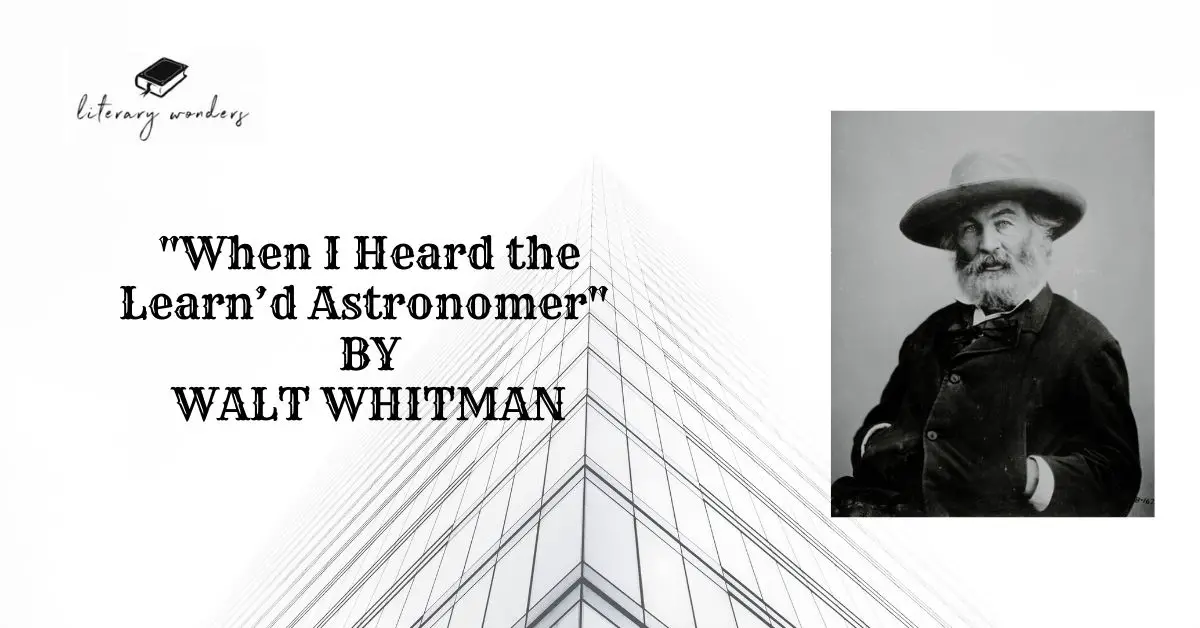
The article, When I Heard the Learned Astronomer by Walt Whitman Analysis will unfold the writer’s ideas about man’s connection to the natural world. Walt Whitman, a great American writer, and poet published this poem in 1865, in his poetry collection, Drum-tap. The poem presents us with a stark comparison between nature and astronomy. It begins when the speaker is present in a lecture hall, listening to the esteemed astronomer’s lectures on stars. The astronomer displays many mathematical figures and proofs to support his scientific knowledge.
To further expand his vision, the astronomer displays various diagrams and charts to detail the mathematical calculations behind them. Although people adore the astronomer for her unparalleled scientific knowledge, the speaker feels uncomfortable. He tries to digest the scientific knowledge for some time, but when the lecture becomes unbearable, he stands up and leaves the lecture hall. However, once out of the world of science, he tries to feel the magical nature. He embraces the silence of damp night while looking at the sky full of stars.
Major Themes in When I Heard the Learn’d Astronomer
When I Heard the Learn’d Astronomer, Walt Whitman’s poem shows themes like man versus nature, knowledge versus experience, and glorious natural world. The poem discusses how the narrator hears an astronomer speak about science and how much the narrator learns from it. After listening to the astronomer’s presentation on stars and constellations made, the narrator questioned his own knowledge of stars and constellations that he thought he once knew so well. The writer urges the readers that instead of following the scientific figures about the universe, try to understand the language of nature by spending some time in its lap.
Although there are many great poems involving astronomy, this poem tries to teach others that science can be fun and exciting rather than boring and uninteresting. In other words, the poem speaks about life and the universe, and it does so with heartfelt language and beautiful imagery. From beginning to end, this poem serves as an example of poetry at its best and as an inspiration to poets everywhere. The absorbing writing style and heart touching meanings of the poem beautifully connect the readers to the writer’s feelings.
Techniques Used in the Poem
Every writer and poet tries to use poetic and literary devices to present their remarkable ideas to the world. Walt Whitman also has used various techniques in this poem while talking about the comfort he receives from the natural world. Below is the analysis of the devices he technically inserted in the poem.
- Assonance: It displays the repetition of vowel sounds in a quick succession such as the sound of /e/ in “heard the learn’d.”
- Anaphora: It refers to the use of words that refer to a word used earlier in the poem to avoid repetition. Walt Whitman has repeated “when” in the opening lines of the poem to emphasize his point.
- Consonance: Consonance is the repetition of consonant sounds in the same line such as /w/ sound in “When I was” and /r/ sound in “heard the astronomer.”
- Imagery: Imagery means using figurative language to presents ideas, actions and objects in a way that they appeal to the reader’s senses. Whitman has used imagery in the poem such as; “the lecture-room” and “in perfect silence.”
- Metaphor: Metaphor is another figure of speech in which words or phrases are applied to an action or object to which they are not literary applicable. Whitman has used natural beauty as an extended metaphor in the poem to show that no diagram or scientific knowledge can describe the comfort it provides to its seekers.
Symbolism: Symbolism is using symbols to present ideas and emotions. The writer has used various symbols in the poem such as; “stars”, “night” and “air” stand for unmatchable beauty of nature. In contrast, “figure”, “proofs” and “columns” display the advancement man has made in the world.
Suggested Reading:

